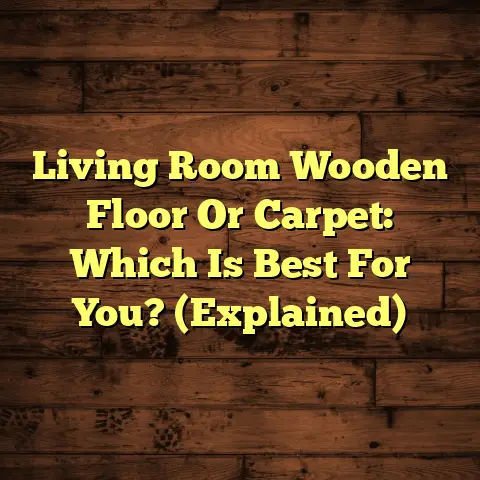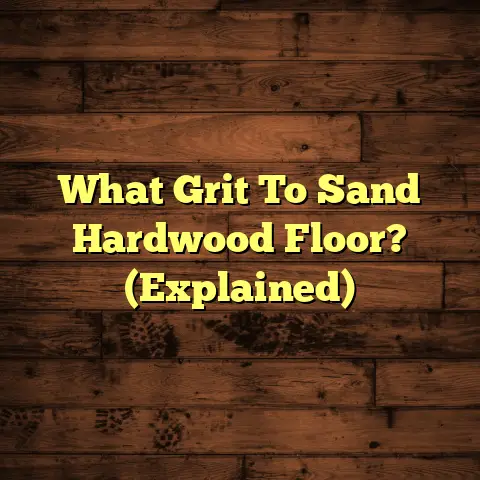Bleach on Wood Floors: Is it Safe? (5 Minute Check!)
What’s your taste in home care—do you prefer the rustic charm of natural wood or the pristine, sterile look of bleach-cleaned surfaces?
I’ve seen it all in my years as a flooring contractor.
From gleaming hardwoods to cozy engineered floors,
wood brings a certain je ne sais quoi to a home.
But let’s be real, life happens!
Spills, messes,
and the never-ending quest for a clean home are constant battles.
That’s where the question of bleach often rears its head.
It’s the go-to for many when tackling stubborn stains
and sanitizing surfaces, but is it really safe for your
precious wood floors?
I’m here to tell you, it’s a bit of a minefield.
This article is your guide to navigating that minefield.
We’ll dive deep into whether bleach and wood floors
are a match made in heaven or a recipe for disaster.
I’ll give you a simple 5-minute check to assess your
floor’s vulnerability and arm you with alternative
cleaning methods that’ll keep your floors looking
their best without the risk of damage.
Think of this as a friendly chat, where I share my
expert knowledge to help you make informed decisions.
Let’s get started and keep those beautiful wood
floors looking their best for years to come!
Section 1: Understanding Wood Floors
Okay, let’s talk wood!
Not all wood floors are created equal, right?
Understanding the type you have is the first step
in knowing how to care for it.
First off, we have solid hardwood.
This is the real deal,
cut from a single piece of timber.
Think classic oak, maple, or walnut floors.
They’re gorgeous, durable, and can be refinished
multiple times, which is awesome for longevity.
Then there’s engineered hardwood.
This consists of
a thin layer of real wood (the veneer) bonded to a
core of plywood or high-density fiberboard.
It’s more stable than solid hardwood, especially in
areas with fluctuating humidity, and often more affordable.
And lastly, we have laminate flooring.
Now, laminate mimics the look of wood, but it’s actually
a composite material with a photographic appliqué
layer on top.
It’s budget-friendly and scratch-resistant,
but it doesn’t have the same warmth or feel as real wood.
The finish on your floor is another crucial factor.
Polyurethane is a super common finish, known for
its durability and resistance to water and wear.
It forms a protective layer on top of the wood.
Oil finishes, on the other hand, penetrate the wood,
enhancing its natural beauty and providing a matte look.
They require more maintenance than polyurethane but are
easier to spot-repair.
Wax finishes are less common these days, but they give
wood a lovely sheen.
They offer minimal protection against
moisture and scratches, so they need regular upkeep.
Think of your wood floor as a living, breathing thing.
It reacts to its environment and needs the right
TLC to stay healthy and beautiful.
Proper maintenance is key to preserving its warmth,
character, and value for years to come.
Section 2: The Chemistry of Bleach
Alright, let’s put on our lab coats for a minute and dive into the science of bleach.
Bleach, at its core, is a chemical compound called
sodium hypochlorite (NaClO) dissolved in water.
It’s a powerful oxidizer, meaning it breaks down
molecules by stealing their electrons.
This oxidation process is what makes bleach so effective
at disinfecting and removing stains.
It attacks the chromophores (color-causing molecules)
in stains, breaking them down into smaller, colorless
compounds.
It also kills bacteria, viruses, and fungi
by disrupting their cellular structure.
According to the CDC, household bleach solutions
typically contain 3-6% sodium hypochlorite.
This concentration is potent enough to kill most
common household germs within minutes.
But, it’s essential to understand that bleach is a
very reactive chemical.
It can damage many materials,
including certain fabrics, metals, and, as we’ll see, wood.
When we compare bleach to other cleaning agents,
like vinegar or baking soda, the difference is stark.
Vinegar is a mild acid, effective for removing
hard water stains and odors.
Baking soda is a gentle
abrasive that can scrub away dirt and grime.
Bleach, on the other hand, is a much more aggressive
chemical.
While its disinfecting power is undeniable,
its potential for damage is significantly higher.
It’s like using a sledgehammer to crack a nut –
effective, but probably overkill and potentially destructive.
Section 3: The Impact of Bleach on Wood Floors
Now, for the million-dollar question:
What happens when bleach meets wood floors?
Unfortunately, it’s usually not a happy ending.
The primary risk of using bleach on wood is discoloration.
Bleach can lighten or even completely strip the color
from wood, leaving behind unsightly white or bleached spots.
This is especially noticeable on darker wood floors.
Bleach can also damage the finish on your floor.
It can break down polyurethane, oil, or wax finishes,
leaving the wood exposed and vulnerable to moisture,
scratches, and other damage.
Over time, repeated exposure to bleach can weaken the wood fibers themselves.
This can lead to cracking, splintering, and an overall
reduction in the lifespan of your floor.
I remember one client who used bleach to clean up a
pet stain on their beautiful oak floor.
They thought they were being proactive, but the result
was a large, discolored patch that stood out like a sore thumb.
The only solution was to sand down and refinish the entire floor,
a costly and time-consuming process.
Another homeowner shared a similar experience online:
“I used bleach to clean a sticky spot on my hardwood floor,
and now there’s a permanent white stain.
I wish I had known better!”
Beyond the immediate damage to your floor,
bleach also has environmental implications.
It releases harmful fumes that can irritate your
eyes, skin, and respiratory system.
It can also contribute to indoor air pollution,
which can be especially problematic for people with
allergies or asthma.
According to the EPA, bleach can react with other
chemicals in your home to form toxic gases.
This is why it’s crucial to never mix bleach with
ammonia or other cleaning products.
Bottom line: While bleach might seem like a quick
and easy solution for cleaning wood floors, the risks
far outweigh the benefits.
The potential for
discoloration, finish damage, wood weakening, and
environmental concerns make it a cleaning agent
to avoid for your precious wood floors.
Section 4: The 5-Minute Check
Okay, so you’re still wondering if you can get away
with using bleach just this once?
Let’s do a quick 5-minute check to assess the risk.
Step 1: Identify Your Finish.
Grab a clean, damp cloth and rub it on an inconspicuous
area of your floor, like under a rug or in a closet.
If the water beads up, you likely have a polyurethane finish.
If the water soaks in, you probably have an oil or wax finish.
Step 2: Inspect for Damage.
Look closely for any existing scratches, cracks, or
areas where the finish is worn away.
These spots are particularly vulnerable to bleach damage.
Step 3: The Bleach Test (Optional, but Recommended).
In that same inconspicuous area, apply a tiny amount
of diluted bleach (1 part bleach to 10 parts water)
with a cotton swab.
Let it sit for 1-2 minutes, then wipe it off.
Step 4: Observe and Wait.
Check for any immediate color change or texture alteration.
If the wood lightens or becomes rough, bleach is a no-go.
Even if you don’t see immediate changes, wait 24 hours
and check again.
Sometimes the damage takes time to appear.
Step 5: Assess Your Risk Tolerance.
If your floor has an intact polyurethane finish and shows
no signs of damage after the bleach test, you might be
able to use it sparingly in a very diluted form.
But honestly, I still wouldn’t recommend it.
What to Look For:
- Color Change: Any lightening, whitening, or discoloration of the wood.
- Texture Alteration: A rough, raised, or uneven texture.
- Finish Damage: A dull, cloudy, or peeling finish.
Remember, this 5-minute check is just a quick assessment.
It’s not a guarantee that bleach won’t damage your floor.
If you’re unsure about anything, it’s always best to
err on the side of caution and choose a safer cleaning method.
Section 5: Alternatives to Bleach
Alright, I’ve convinced you to ditch the bleach, right?
Good!
Now, let’s talk about some safe and effective
alternatives for cleaning your wood floors.
Vinegar: This is a classic, natural cleaner that’s
mildly acidic, making it great for cutting through
grease and grime.
Mix 1/2 cup of white vinegar with
1 gallon of warm water for a gentle cleaning solution.
Always wring out your mop thoroughly to avoid excess water.
Baking Soda: This is a gentle abrasive that can
scrub away dirt and stains.
Make a paste of baking soda
and water, apply it to the stain, and gently rub with
a soft cloth.
Rinse with clean water and dry thoroughly.
pH-Neutral Cleaners: These are specially formulated
for wood floors and won’t damage the finish.
Look for cleaners labeled as “pH-neutral” or “wood floor cleaner.”
Follow the manufacturer’s instructions for use.
Bona is a popular brand that I often recommend.
Homemade Cleaning Solution Recipe:
- 1/4 cup white vinegar
- 1 tablespoon liquid castile soap
- 1 gallon warm water
Mix all ingredients in a bucket.
Dampen a mop with the solution and wring it out thoroughly.
Mop the floor in the direction of the wood grain.
Rinse with clean water if needed and dry thoroughly.
Preventive Care is Key:
- Sweep or vacuum regularly to remove dirt and debris.
- Use mats at entrances to trap dirt and moisture.
- Clean up spills immediately to prevent staining.
- Avoid wearing shoes on your wood floors.
- Use furniture pads to protect against scratches.
By incorporating these simple practices into your routine, you can minimize the need for harsh cleaning agents and keep your wood floors looking their best for years to come.
Section 6: Conclusion
So, we’ve journeyed through the world of wood floors
and the potential pitfalls of using bleach.
We’ve explored the different types of wood flooring,
the chemistry of bleach, and the risks it poses to
your floors.
We’ve even armed you with a 5-minute
check to assess your floor’s vulnerability.
The key takeaway here is that while bleach may be a
powerful disinfectant, it’s simply not worth the risk
when it comes to your wood floors.
The potential for
discoloration, finish damage, wood weakening, and
environmental concerns far outweigh any perceived benefits.
I urge you to embrace the alternative cleaning methods
we’ve discussed.
Vinegar, baking soda, pH-neutral cleaners,
and simple preventive care can effectively maintain
the beauty and integrity of your wood flooring without
the harsh chemicals and potential damage.
Remember, your wood floors are an investment.
Treat them with the care and respect they deserve.
By choosing gentle, safe cleaning methods, you can
preserve their beauty and enjoy their warmth and
character for generations to come.
Final Thoughts
As you consider your cleaning choices, remember that
your home is more than just a building – it’s a sanctuary.
The products you use have a direct impact on your
indoor environment and the health of your loved ones.
Choose wisely, and create a home that is both clean
and healthy.
I’d love to hear about your experiences cleaning wood floors!
Do you have any favorite tips or tricks to share?
Let’s foster a community of shared knowledge and help
each other keep our wood floors looking their best.





